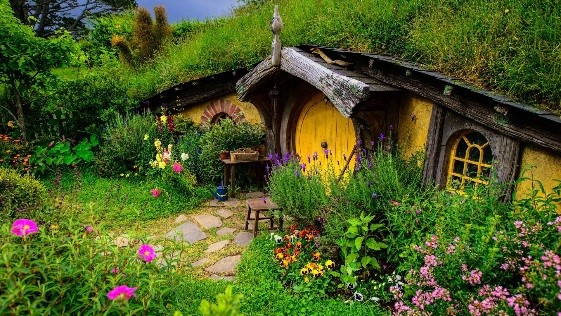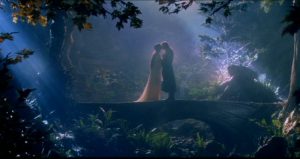Fantasy Soundtracks: The Lord of the Rings and Leitmotifs
We’ve heard game developers and film directors speak about it countless times. Extended credits and lengthy special features are devoted to it. Music! Much of what we enjoy in our favorite games and films would be drastically diminished without its accompanying musical score. Some of our most cherished scenes and play experiences are framed by iconic melodies.
Who would Luke Skywalker be without the Binary Sunset theme? Just some kid with sand in his eye, that’s who. What would the PS4 title, The Last Guardian be without its full symphonic soundtrack? Just a fancy-looking puzzle, buddy!
In The Fantasy Hive’s musical feature, Fantasy Fanfare, I’ll focus on specific fantasy music as well as a particular musical technique or topic, to explore how film and game composers enhance the characters and worlds we have come to love. From time to time, I will also be doing reviews of soundtracks, because as many of us know, we get a lot of enjoyment from listening to them outside of watching or playing.

Leitmotifs (themes) in The Fellowship of the Ring OST
For the first Fantasy Fanfare feature, I had to go big. Had to! The Lord of the Rings, man! Seeing that the books (well, originally, book) are some of the most realized and cherished sources of modern fantasy literature, the soundtrack for the first LotR film was the obvious inspiration for the inaugural Fantasy Fanfare article.
The soundtrack for Fellowship had to be massive, profound, but also subtle when necessary. It had to help sell the notion of “the doom of man,” and at the same time, communicate the innocence and simplicity of a hobbit planting flowers. How did Howard Shore tackle such a task?
One of the biggest composition techniques that helps bring a soundtrack to life—and in turn, helps bring very necessary musical context to a film—is using leitmotifs. Beyond the academic definition, think of leitmotifs as the things that pop into your head and transport you instantly, and vividly, into a memory, or into your imagination.
Your uncle Bob’s annoying laugh when he was drunk at Christmas six years ago.
The smell of your first car.
The feel of your first girlfriend’s/boyfriend’s lips when you kissed.
The minute someone says Bob—BAM: annoying laugh. Someone talks about your old ’82 pickup truck? BOOM: stale cigarette smoke. Your first boy/girlfriend’s lips? POW: [insert innocent or naughty memory here]. Musically, leitmotifs attempt to serve the same purpose in film.
Someone says hobbit? You hear this. You see this:

To help guide a viewer through a film, to increase immersion, and provide context, composers use leitmotifs to their advantage—to reinforce that sense of association. If a film’s cinematography, pace, and/or plot are complex or erratic, a composer can help alleviate that somewhat by anchoring characters with recurring, memorable melodies. It can sometimes accidentally, or purposefully, be the only thing that helps keep a viewer/player grounded in the experience.
Even if the film is straightforward or easy to follow, those melodies help add that much more context to a scene or character. And the ability to compose one memorable theme is challenging enough. In the case of Fellowship, Howard Shore had to do this dozens of times.
That last link, “Concerning Hobbits,” was a prime example of the concept. Every time you hear it, you think of hobbits, the simpler life, gardening, ale, smoking pipe-weed, and the peace of nature. In the film, listen for it every time Frodo, Sam, Bilbo, any hobbit, harkens back to simpler days in the Shire.
Creating that sense of immersion takes much more than just the general “happy” vibe created by the upbeat melody, however. The composer needs to think very carefully about which instruments will play the music, which is known as orchestration. Think of a whole soundtrack as an entire painting, the leitmotifs as the sections of a painting your eyes are most drawn to, and the selected orchestration as the brushes.
In needing to create a rural, wholesome, and relaxed sense of folk music for the hobbits, Howard Shore turned to the classic instruments of folk music: the dulcimer, the fiddle, and as can be heard at the beginning of the above “Concerning Hobbits” track, the tin whistle.
The fiddle and whistle are light and airy. They whip to and fro with quick glances of playfulness—like skipping along, carefree, down a country road. The accompanying strings behind the initial whistle’s solo are rich at times, or later, during the fiddle solo, it skips along with the fiddle to possibly convey a sense of a group of hobbits heading home after sharing in an innocent night at the Green Dragon. It sounds rustic, and humble.
This helps immerse the viewer in the film. It helps place you in the group, (or fellowship), next to Sam, Frodo, Pippin, and Merry. When the trail gets tough, and they start missing the Shire, you’re right there with them. Right there in that memory with some ale, a pipe full of tobacco, and a few hobbits in the corner with their whistle and fiddle.
Halflings aren’t the only culture that get their own leitmotif, or theme. How about the elves of Rivendell and the House of Elrond? Check this excerpt out. When the track starts, our ears are immediately smothered by a group of ethereal sopranos; women singing high with a lot of reverb (the effect of being in an unending or cavernous space), almost as if they’re surrounding us in the hills and mountains, draping us in a veil of immortal dreams and pillows. Whoa!

And while this isn’t in Fellowship specifically, listen to how the Rivendell music gets brought back in Return of the King when Elrond brings Andúril to Aragorn. Listen to the similarities, but listen back and forth to hear the differences. The Andúril variations have much more going on in the strings after the very subtle horn solo, but the melody is the same. Why? Because Andúril was made by the elves of Rivendell.
As a fun comparison of the music related to the elves, listen to the theme associated with Lothlorien. Again, we have those distant female vocalists, making us feel like we’re in a different dimension, or maybe even in the Grey Havens. But what’s different about this music in comparison to the music of Rivendell? The Lothlorien vocalists are singing lower. There are sopranos and altos this time, and they’re moving more slowly between notes. And, there’s a bit more of a hint of dissonance—notes that don’t sound as pleasing to the ear when played together. The distinction between Rivendell and Lothlorien is very deliberate. Why is that? Even when the vocalists return a few minutes after the initial theme, there’s still a bit more mystery and suspicion in the music for Lothlorien.
Think of a whole soundtrack as an entire painting, the leitmotifs as the sections of a painting your eyes are most drawn to, and the selected orchestration as the brushes.
You may ask, “Do only people and cultures get their own music, Jeramy?” Heck no! How about love?
“What? Love, Jeramy? How the heck can something as abstract as love get its own theme? How does one musically convey love?”
Well, I’ll tell you how. Enya, the composer and singer of/in this piece, had inspiration. We all know about the comparison between Aragorn’s and Arwen’s love to Beren and Luthien, right? The power of love transcending life and death? Love helps bridge the gap between men’s mortality and the immortality of the elves.

Like Howard Shore does, Enya calls on the style and mood of ethereal, spacious, cavernous singing. It’s rich and eternal. (On a personal note, I think this is one of the most beautiful pieces of music I’ve ever heard, and this is coming from a guy with a degree in music.)
But this theme is much more personal than the ethereal pieces of the elves as a culture. It’s one singer. There isn’t *as much* reverb. And the one voice, coasting slowly over a small (but then later, larger) group of strings, commands us to listen to the promise of love’s immortality.
Now, you can’t have something as beautiful as love without contrasting it with depravity and hate, right? The treachery of Saruman is at the other end of the spectrum, throwing rocks at and mocking the love between Aragorn and Arwen. Where the love theme is transcendental, spiritual, and puts the priority of love on a modest pedestal—inspiring all creatures to prioritize it and reach for it—the melody of Saruman’s deception is the exact opposite. It shuts out the world, hates those in it, and retreats off into a corner to think of ways to destroy the world. It initially forsakes melody for a mindless, percussive dirge.
The first thing you hear is the metallic clang of mallets and anvils, stamping and beating out evil’s armor. Like an endless conveyer belt churning out disease, the repetitive, rhythmic pulses put you down in the caverns and crevasses with the orcs and Uruk-hai. And just when you feel like you’ve been assimilated into the throng of war’s industry, here comes the low brass—slave masters, or Saruman himself, barking new orders. The echo of the brass’ first blast then sends the orders down the lines.
The music of war gets interrupted while Gandalf arranges his escape, but the orcs and Uruk-hai are undeterred. Their hate and motivations of destruction return with that much more vigor. Listen for the louder anvils, and this time, chains.

So, there we have it, my friends! A little fun exploration into the concepts of leitmotifs/themes, and how composers use them to help anchor us, help us associate characters, events, and locations. Keep an ear out for various themes in films, and as you do, think about how they sound different. Are they louder? Slower? Played or sung by different instruments and voices? They’re all clues that can help us enjoy a film or game that much more, and help us remember, or even forecast, events.
What are some of your favorite musical themes from fantasy movies and games? Let me know if there are any topics you’d like discussed or soundtracks you’d like reviewed! Thanks for reading!

The LOTR soundtrack was indeed the perfect complement for the amazing visual experience of seeing Tolkien’s world translated to the big screen, and since that musical score was an emotional complement to the scenery, I never stopped to think about the actual elements that carried those emotions through. So, thank you so much for this delightfully informative post! 🙂
Leitmotifs >> Wagner >> Der Ring des Nibelungen >> be still, my heart <3
Yes!! Ooohh, and speaking of Wagner.. Wagner in Excalibur!! https://www.youtube.com/watch?v=XxSeeN03Xfg&t=46s